Who do you think would win in a fight between a flock of bald eagles and a massive grizzly bear? It’s one of the most bizarre animal battles yet, and we’re here to walk you through each round of fighting. Follow along as we discover the advantages, and disadvantages each competitor brings to the ring. At the end, we’ll decide once and for all who deserves the championship title. Will it be the angry flock of bald eagles? Or the enormous grizzly bear? Read on to find out.
Flock of Bald Eagles
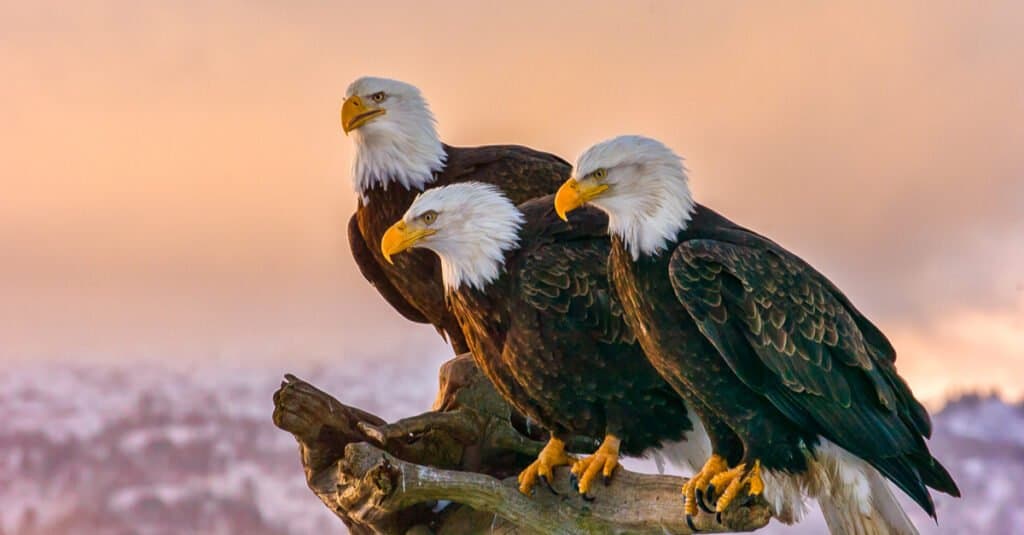
As apex predators, bald eagles use their strong talons and powerful beaks to secure prey.
©FloridaStock/Shutterstock.com
Introducing our first competitor, a flock of eagles. With strong talons, beaks made for crushing, and incredible eyesight, bald eagles seem to have it all. If something possessed these birds to attack a grizzly bear, they could inflict some serious damage.
Bald eagles sometimes slap grizzly bears in the face, but would they have what it takes to kill one? The answer would depend on how many birds were in the flock. A large flock (although unlikely to ever occur) could overpower a massive grizzly. But it’s more likely the bear would flee to safety before becoming a meal for the birds.
Eagle Advantages: Stamina and Incredible Eyesight
Bald eagles can fly long distances, covering as much as 3,000 miles as they soar across the ocean. Along with going far, they also go way up high. They can soar over 10,000 feet high where they can spot prey far off in the distance. They can even spot other eagles soaring as far as 50 miles away.
A bald eagle’s incredible eyesight allows them to see 4 to 5 times better than humans, they can also see colors invisible to humans like ultraviolet light. Along with seeing clearly over for miles, bald eagles also have amazing peripheral vision. Their field of view nearly wraps around their head with an astounding 340 degrees of vision.
Massive Grizzly Bear
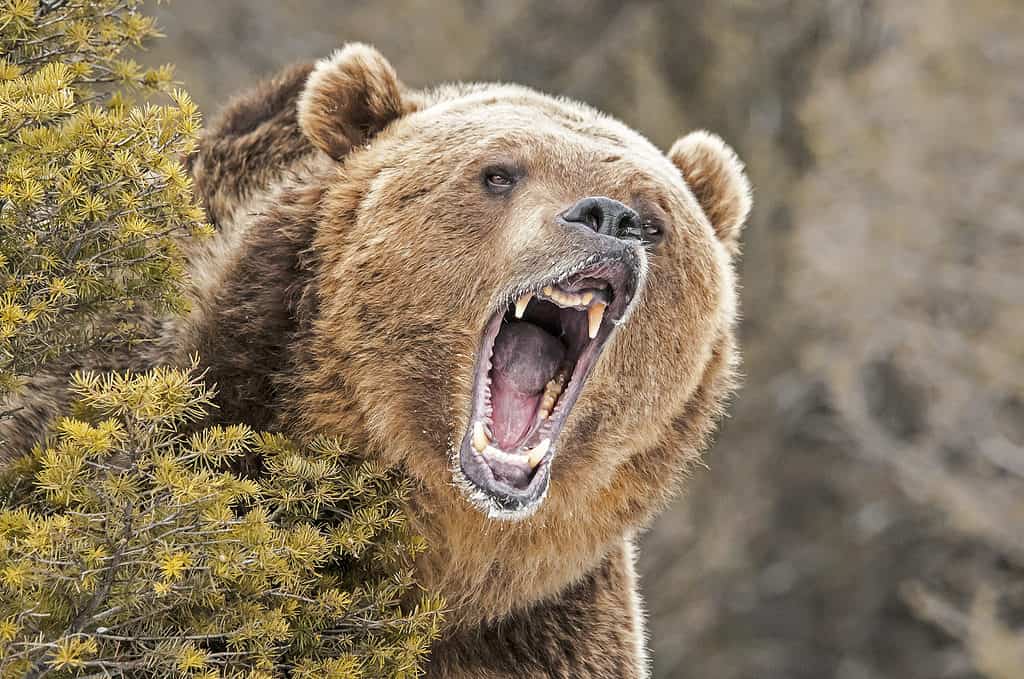
Grizzly bears are bold enough to steal food from hungry packs of wolves.
©Scott E Read/Shutterstock.com
Our second competitor stands over 10 feet tall and weighs more than 1,000 pounds. Grizzly bears are an unstoppable force, capable of taking on a pack of wolves. In one video a grizzly bear steals a fresh kill from 15 angry wolves. When they try to reclaim their meal, the bold bear scares them off one by one. If this bear is willing to take on an entire pack of wolves, it can likely hold its own against a flock of bald eagles.
Grizzly Bear Advantage: Does Whatever It Takes to Win
Grizzly bears are solitary animals. So, if a flock of eagles were to attack, the bear wouldn’t have protection in numbers. They’d have to win the fight all by themself. But that doesn’t mean they’d be sweating it. Using their aggressive attitude, long claws, and immense size, grizzlies know how to win a fight. And a provoked grizzly bear is a force to be reckoned with.
An angry grizzly will go all out to prove their point and eliminate the threat. However, most of the time these bears are fairly laid back. They’re usually more interested in plants than meat. Surprisingly, 80-90% of their diet consists of vegetation. As omnivores, they feed on berries, grass, roots, and other tasty plants.
Would a Flock of Eagles Attack a Grizzly?
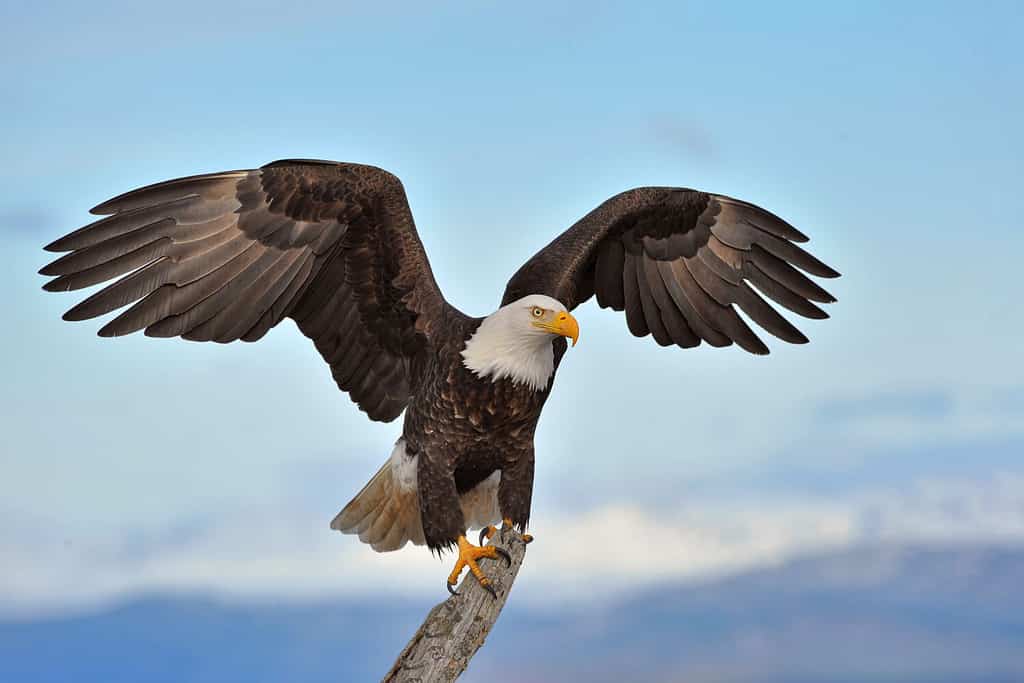
The chances of a flock of eagles attacking a grizzly bear are pretty low.
©FloridaStock/Shutterstock.com
On a scale from 1-10, the chances of a flock of eagles attacking a grizzly bear is somewhere around the 0 mark. For starters, eagles don’t fly in “flocks”. Instead, a group of eagles is called a convocation, soar, aerie, spread, or kettle when soaring in circles.
Bald eagles fly in circles for a reason. They use the thermal columns to effortlessly gain altitude. Their long, broad wings can ride the warm air, and eagles don’t have to waste any energy flapping. Instead, they save all of their strength to attack prey. These birds have an attack speed that can reach up to 100 miles per hour, earning them the title of “king of all birds”. As they swoop down, their talons snatch up prey with a grip strength that’s at least 10 times stronger than that of a human.
Bald Eagles Prefer Stealing Over Killing
If two grizzly bears got in a fight, and one killed the other one, the bald eagles might feast on the carrion. Otherwise, they’ll probably never know what bear meat tastes like. These birds love stealing so much that their thievery skills almost kept them from becoming the United States’ national bird.
Take a look at what Benjamin Franklin wrote about bald eagles and their notorious reputation:
“For my own part, I wish the bald eagle had not been chosen as the representative of our country. He is a bird of bad moral character. He does not get his living honestly. You may have seen him perched on some dead tree, where, too lazy to fish for himself, he watches the labor of the fishing hawk; and when that diligent bird has at length taken a fish and is bearing it to his nest for the support of his mate and young ones, the bald eagle pursues him, and takes it from him.”
One of the ways bald eagles steal is by harassing other fish-eating birds until they get fed up, and give up their kill. They’re shameless about doing this and won’t think twice before stealing food from hawks or ospreys. They’ll also scavenge meals and have even been seen eating roadkill or rummaging through dumpsters.
Would a Grizzly Bear Eat a Bald Eagle?
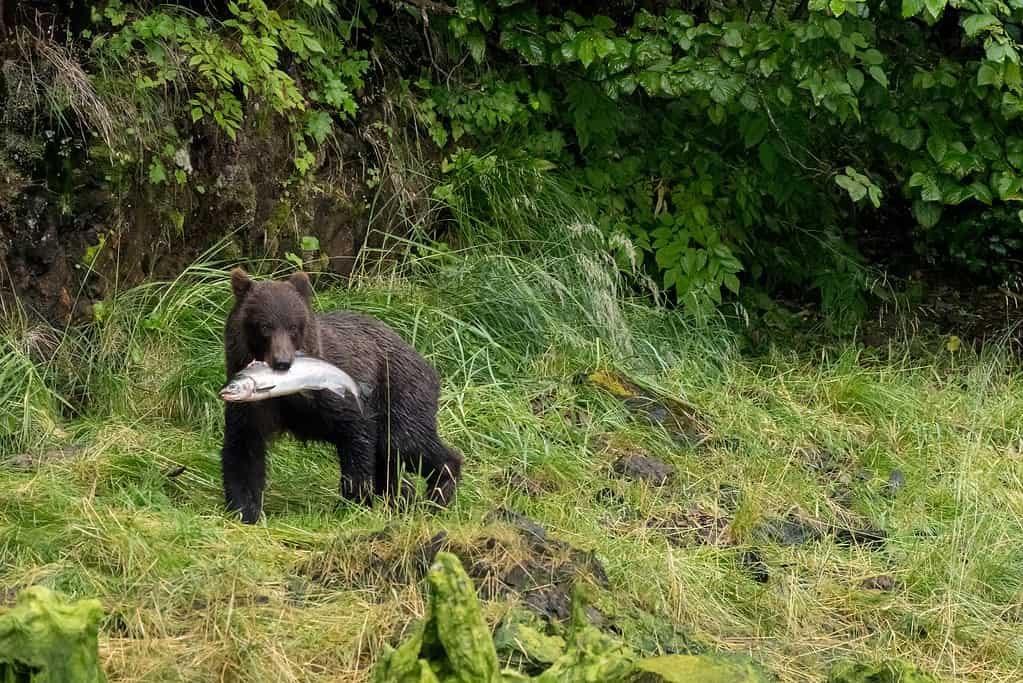
Although they sometimes eat birds that nest on the ground, grizzlies are more interested in fish.
©Kirk Hewlett/ via Getty Images
A grizzly bear would happily eat an already dead bald eagle. These bears love carrion. But, what are the chances of a grizzly picking a fight with a flock of living eagles? As fun as it is to imagine this bizarre scenario, the truth is it’s not likely it’d ever happen.
Bears eat birds, but it’s difficult to catch them. To shift the odds in their favor, most bears focus on birds that are already close to the ground. Avian species that nest or forage on the ground are the most likely candidates to be eaten. Since bald eagles nest way up in the trees, they’re not even on the grizzly bear’s radar.
Grizzly Bears Prefer Plants and Easy Prey
When they do eat meat, grizzlies prefer foods like fish, rodents, and young deer. All of these prey animals are an easy catch for a skilled grizzly. They possess an extraordinary sense of smell, which is seven times better than a bloodhound. Because of this, grizzlies can smell a meal miles away.
Round 1: Fighting Skills

Bald eagles sometimes fight each other over territorial disputes; these fights can be deadly.
©Greens and Blues/Shutterstock.com
How do bald eagles fight? By screaming, soaring, and scratching. They’ll emit a high-pitched scream when another eagle threatens their territory, and soar high up to circle above the intruder. Then the upper bird dives with extended talons, while the lower bird flips its talons up. Eagles have four talons on each foot that they can close with a vice-like grip thanks to strong leg muscles.
How do grizzly bears fight? Standing up. Clacking teeth and paw pounding are signs of an impending attack. They’ll also stand up on their hind legs. Standing gives them the advantage of biting the other bears’ throats or spines.
Territorial Eagle Fights
Why do eagles fight? It’s not because they’re angry or aggressive, they just don’t like intruders. Eagles are strongly territorial, especially during nesting season when these fights are most likely to take place. These talon battles can lead to serious injuries or even death for one or both birds.
Territorial Grizzly Fights
As for grizzly bears, they too engage in territorial disputes with members of their species. However, while bald eagles might fight to the death, grizzlies are more likely to let the losing bear flee.
Grizzles are built for hunting large prey, digging up roots, and competing for mating rights. Their long dexterous claws are 4-6 inches long, which is great for digging and slashing. They also have a hump over their shoulder that helps them run fast and maintain endurance. And let’s not forget about their 3-inch long fangs, strong jaw, and massive bite force that can crush bowling balls.
Round 2: Hunting Strategies
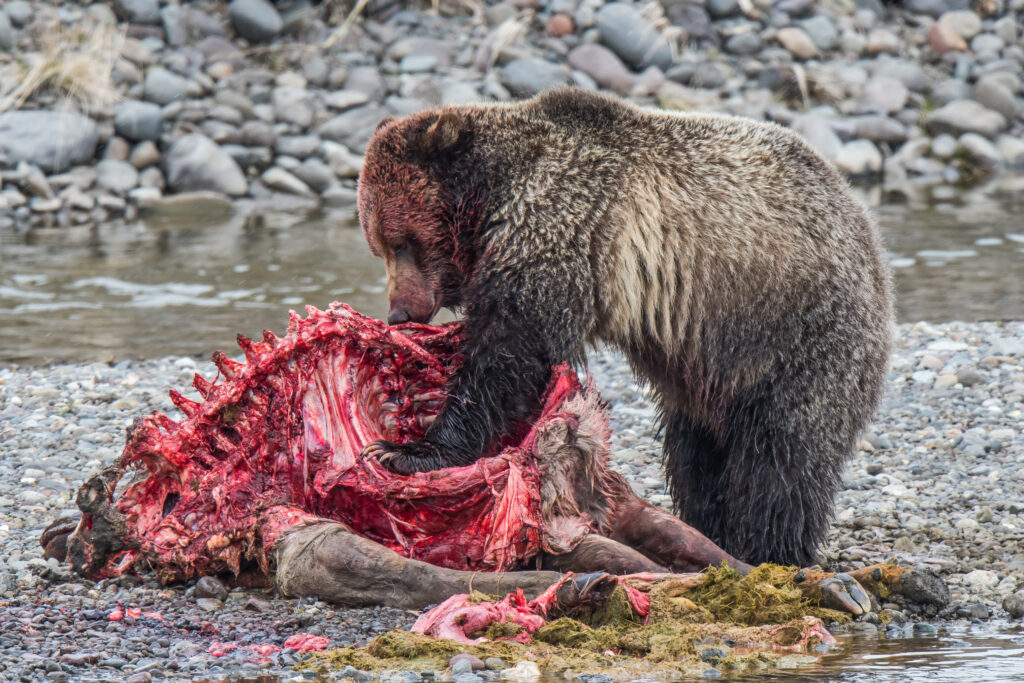
After killing its prey, grizzlies like to eat the entrails first, and then start on the chest of the carcass.
©Bobs Creek Photography/Shutterstock.com
Bald eagles use their excellent eyesight, large talons, and a hooked beak to catch all sorts of prey. They primarily eat fish but also dine on ducks, turtles, snakes, rodents, and other small mammals. All of these prey animals are perfect for the eagle’s hunting style, which involves flying high and then swooping down to grasp prey with their powerful talons.
Eagles can even fly off with the prey in tow. But that won’t be possible when they’re up against a massive grizzly bear. A bald eagle can only carry around 7 pounds or half of their body weight. If they’re fighting a 700-pound bear, it would take 100 birds to lift them off the ground.
Eagle’s Hunting Strategy
How would a flock of eagles hunt a grizzly bear? They’d have to resort to dive attacks, and it’d take numerous swooping blows before they could inflict any serious damage. Part of the problem has to do with the thick fur covering the brown bear’s vital areas. Even though an eagle’s talons are tough, they might not be tough enough to get through the fur and pierce flesh.
Plus, the grizzly isn’t going to be staying still during this attack. So inflicting lethal damage will be all the more difficult. Every time they swoop in, they’ll be risking the chance of the bear’s paw slapping them to the ground.
Grizzly Bear’s Hunting Strategy
Grizzlies have two primary tactics when hunting: biting and hitting. First, they target the neck or back of their prey with lethal bites. Sometimes they bite the snout of their prey, other times they go for the back of the neck.
Along with biting, this bear is also skilled at striking. All it takes is one strong swipe from their powerful forepaws to snap a spine in two. Brown bears are so confident in their abilities that they’ll steal food from a tiger, knowing they can survive the counterattack.
After killing its prey, grizzlies like to eat the entrails first, and then start on the chest of the carcass. They save leftovers by hiding them under moss, soil, snow, or even flowing water. But there probably won’t be any leftovers after this fight. Grizzly bears can eat about 30 pounds of meat a day, and most bald eagles only weigh between 6.5 to 14 pounds.
Round 3: Super Senses

Bald eagle’s eyesight is so superior they can see a mouse or rabbit up to two miles away.
©Radka Smach/Shutterstock.com
The final round of this animal battle is all about senses. Who has the best senses in a fight between a flock of bald eagles and a massive grizzly bear? It looks like this round might be a tie. Our avian fighters can see better, but the bear has the advantage when it comes to sense of smell.
Bald Eagle Senses
Bald eagles win when it comes to eyesight. These birds can see four or five times further than the average person thanks to all of the cone cells in their retinas which enhance their ability to resolve fine details. They can voluntarily dilate and constrict their pupils to focus near and far. While in flight, they can spot a rabbit or mouse two miles away.
As for hearing and smell, they have these senses, but they’re not nearly as powerful as their eyesight. Instead, you can compare a bald eagle’s hearing and smell to that of humans. They simply don’t need the super-powered hearing and smelling senses that night-time hunting raptors rely on.
Grizzly Bear Senses
Grizzly bears take a big win in the sense of smell department. Compared to a human, their smelling capacity is 2,100 times better. Their super-smelling abilities are thanks to the design and size of their nose. Grizzlies have a honeycomb-like nasal cavity, increasing the surface area for millions of scent receptors. And there’s plenty of room to take in every scent. The inside of a grizzly bear’s nose is 100 times larger than a human’s. To process all of the scent information, the olfactory bulb in their brain is at least five times larger than ours.
Grizzly bears also take a win in the hearing department. They possess three middle ear bones (malleus, incus, and stapes) that make them highly sensitive to sound. Bear hearing is twice as sensitive as humans, detecting a wide range of frequencies.
As for vision, grizzly bears don’t have the super-sight abilities eagles are known for. They have good vision, but they can’t see for miles. Instead, their up-close eyesight is comparable to humans, but long-distance vision is less detailed. They can tell what type of animal they’re looking at as far as 200 yards. But their vision beyond the 200-yard mark remains untested.
Who Wins?
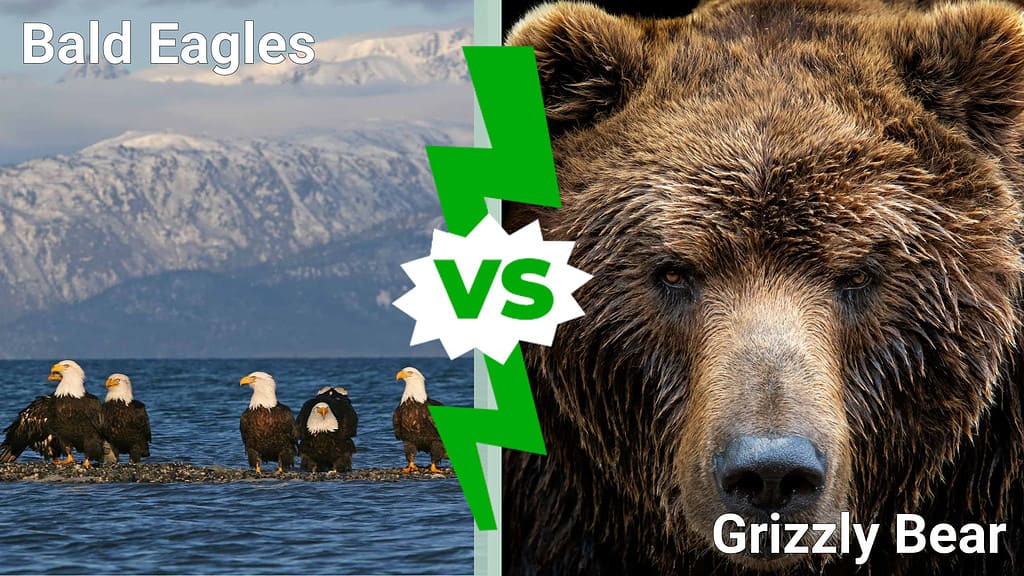
In a flock of eagles vs. massive grizzly bear fight, we have a tie.
©Silfox and Lubos Chlubny/Shutterstock.com
We have a tie, for our flock of bald eagles vs. a massive grizzly bear showdown, and here’s why. Neither the grizzly nor the flock of eagles was able to gain enough of an advantage to win this fight. This fight would likely end with both competitors walking or flying away in defeat.
For starters, the chances of a flock of eagles attacking a grizzly bear is pretty much impossible. Eagles are solitary hunters, who only occasionally team up. But even a large group of eagles wouldn’t be foolish enough to try to take down a massive grizzly bear. Instead, they focus on more reasonable targets, like salmon.
If a scenario somehow came to be where a flock of eagles did target a grizzly, they’d have trouble delivering a fatal blow through all of the fur. And the eagles would be risking their lives every time they swoop in.
All it takes is one strike from the grizzly’s strong paws to kill whatever unfortunate bird was their target. After seeing the grizzly wipe out a few members, the rest of the flock might fly off in retreat. Or, it could be the grizzly who runs away, seeking refuge in the dense cover of the woods. Since neither competitor can completely wipe out the other one before they escape, this animal battle is a tie.
Why Don’t You See Flocks of Eagles?
Why don’t you see flocks of eagles flying around? Eagles may group up where food is abundant, like during salmon runs in the Pacific Northwest. But otherwise, these birds prefer to do things their own way. They’re solitary hunters who are incredibly good at what they do. It’s not likely you’ll ever see a group of bald eagles unless you come across a communal roost.
55 Eagles in One Tree
Can you imagine what it’d be like coming across not one, not two, but 55 bald eagles in the same spot? Photographer Chuck Hilliard caught such a moment on camera when he came across 55 bald eagles in a big tree serving as their community roost.
Communal roosts are noisy spots where bald eagles get to mingle, find pairs, and communicate. Perched high up in the tree, these majestic birds communicate with shrills, screeches, and warbles, creating a lot of chatter. These roosts are usually located in large living or dead trees, sheltered from the wind, and near food sources. Once you find a communal roost, take note of the location. Oftentimes, eagles will come back year after year to the same spot.
Do Grizzlies or Bald Eagles Have Predators?
As apex predators, grizzlies and bald eagles don’t have to worry much about being attacked. Instead, some of the biggest threats are from humans. Grizzlies suffer from habitat loss, and bald eagles become victims of gunshot wounds, poisoning, and electrocution.
Bald Eagle Population
Around 316,000 bald eagles live throughout the United States. Only two eagle species, the bald eagle and golden eagle, are common in North America. These birds mature by age four or five and mate for life after engaging in courtship rituals. Breeding usually occurs in January and February, with females laying one to three eggs. During breeding season, eagles stay with their mates until eggs hatch into eaglets.
Grizzly Bear Population
Only around 2% of grizzly bears remain in the contiguous United States, with their population currently estimated to be around 50,000 in North America. Along with habitat loss, one of the major issues impacting grizzly bear population numbers has to do with how they reproduce. Grizzlies have one of the lowest reproductive rates among mammals since they don’t reach sexual maturity until 4.5 to 10 years of age. They can survive up to 34 years in the wild, but 15-25 years is the average lifespan.
The photo featured at the top of this post is © Silfox and Lubos Chlubny/Shutterstock.com
Thank you for reading! Have some feedback for us? Contact the AZ Animals editorial team.






